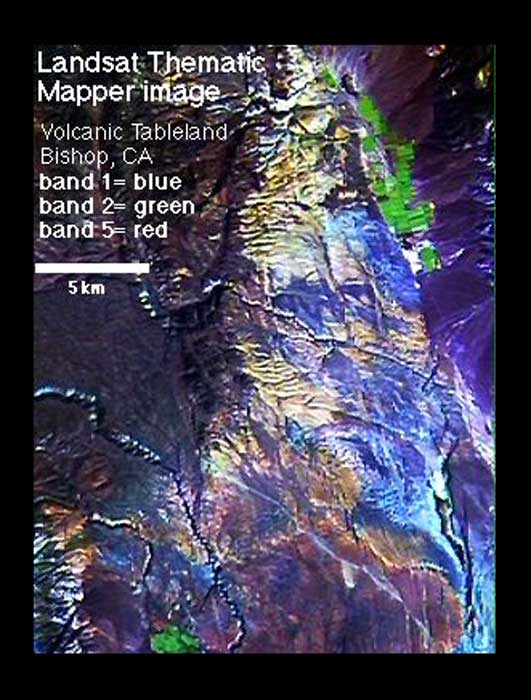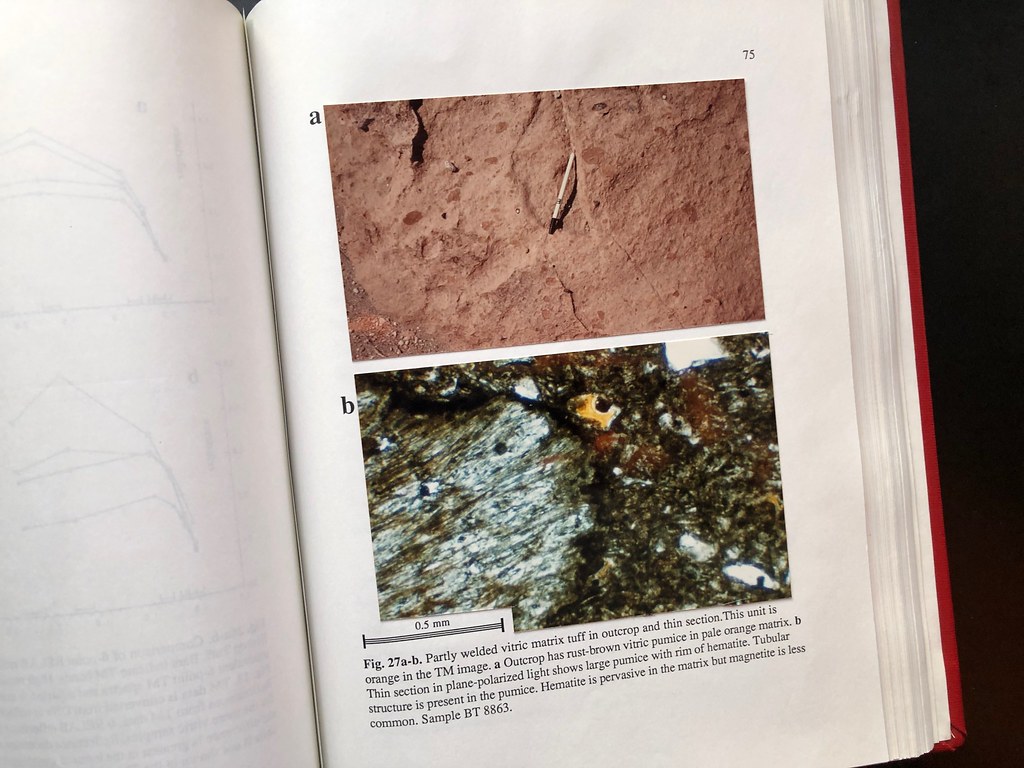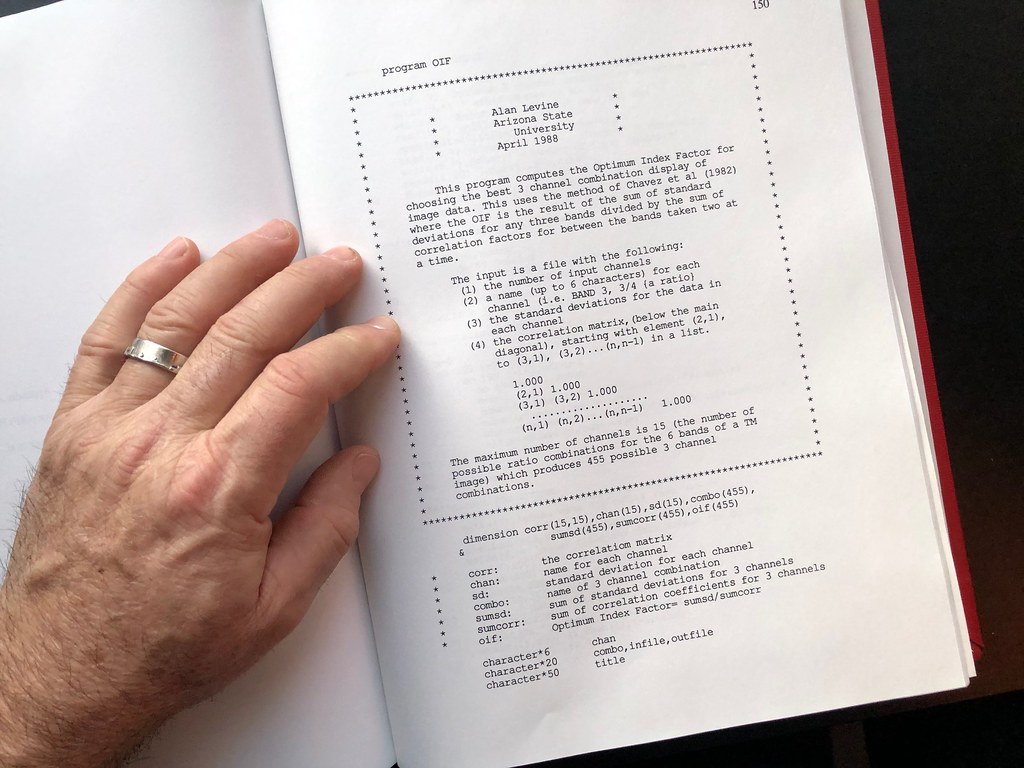I thought this was going to be a small digital cleanup project I could cross off my list over the holiday break. But like many tasks, when you pop open the hood (bonnet for those elsewhere), there ends up being more than you expected.
There is a publication I wrote in (gasp) 1989 that I want get online. It is digital, yes, but the challenge may be hinted at this photo that shows the media it was stored on.
Yes that top floppy disk was the one where the files were stored to write this:
I imagine scores and scores of readers here are eager to have online access to “Ash Flow Zones of the Bishop Tuff: Detailed Mapping with Landsat Thematic Mapper”, my 1989 MS Thesis in Geology from Arizona State University.
The abstract should get you craving more, more, more:
Landsat Thematic Mapper (TM) data is used to map in detail the distribution of ash-flow zones of the Bishop Tuff exposed in the Volcanic Tableland, near Long Valley, California. Laboratory data demonstrate systematic changes in the reflectance of the Bishop Tuff associated with degree of welding and vapor-phase crystallization. Reflectance spectra of vitric, non-welded tuff have absorption features indicative of ferric iron and water, the latter in pore spaces and as well as in hydrated glass. With greater degrees of welding, reflectance drops with the change from ferric to ferrous iron in increasing amounts of opaque, low reflectance magnetite. The water absorptions disappear with the loss in porosity and decreasing proportion of glass. Vapor-phase crystallization of silica and alkali feldspar, minerals lacking absorption features in the visible and near infrared wavelengths, produce flat reflectance spectra.
Reflectance derived from the TM data are semi-quantitatively compared to the laboratory reflectance measurements and show consistent trends between the mapped geologic units. These units identified from the TM data and verified in the field include non-welded tuff, two types of partly welded tuff (vitric and crystalline matrix), and three types of vapor-phase crystallized tuff (moderately crystalline, strongly crystalline, and oxidized). Individual fumarolic mounds were recognized and mapped from the TM images. Three alluvial units dominated by rhyolite, granite, and granodiorite were differentiated in both laboratory reflectance and TM data.
Strongly crystalline vapor-phase units and the fumarolic mounds overlie the thickest zones of dense welding. This indicates that thickest accumulations of the Chidago lobe are along the east side of its present outcrop area, and reflect an east dipping pre-existing surface covered by the pyroclastic flows. The distribution of the Tableland lobe is mapped from the TM data and includes several thin flow units further north than previously reported. A previously unrecognized alluvial sheet of rhyolitic gravel deposited on top of the Bishop Tuff is also mapped. This sheet correlates with the resurgent doming of Long Valley caldera that initiated overflow of a Pleistocene lake occupying the caldera. This correlation assigns an approximate age of 0.6 Ma for the deposition of the alluvial sheet. Chidago Canyon must have been incised prior to 0.5 Ma, when the lake had dropped to a level at which most drainage was through the Owens River. Relative age relationships observed in the TM data bracket the age of faulting east of Casa Diablo Mountain between deposition of the alluvial sheet and carving of Chidago Canyon, or between 0.5 and 0.6 Ma.
Technically it is in digital format, I have the original files I put into MS Word 3 for Mac, composed on a Mac Plus. Over the years I tried to open them in a modern version. Maybe 10 years ago I read somewhere that I needed to get them first into Word 4 which then could export to a modern format. I even bought a copy of Word 4 on eBay but I could not get it to install on even my old Mac.
I forgot about it until a few weeks ago. I took a dip into the search realms again, and came across a link to a Word Legacy File Filter sitting inside, yes folks, a tilde space for someone at Columbia University.
With a little bit of poking around I find that “~em36” is Edward Mendelson. And just for curiosity click sake, going to the main entry to Edward’s tilde space opens all kinds of curious rabbit holes to click open. To me, these kinds of web corners are infinitely more interesting than seeing who is reacting with an emoji to a tweet someone linked that I was mentioned in (can you tell how effing bored I am with twitter?)
Back to the topic. The Word Legacy File filter looked promising, but I would need a Windows machine to try it out. Despite my rants, twitter can be useful when deployed with an ask:
I probably did not have to mention Ken Bauer, but in typical fashion he responded with an affirmative
And in a few hours, my five Word Files, some 31 years old, were there for me to open in the copy of Word on my computer in 2020. Before I get to share what I found, a special hat tip to Frederick Graver for connecting me to the Macintosh Garden, as I found some gems of old game software there I used for projects in the mid 1990s (that’s another post)
On a quick check, I could see in the files Ken sent back that the majority of the formatting was there. My plan was first to get a clean and pretty version in Word so I could generate a PDF, and then look at making a web friendly version.
While everyone’s impulse these days screams PRESSBOOKS! PRESSBOOKS! PRESSBOOKS! I wanted to try something different and something I could host on my own domain. Sure, I could get it inside a WordPress site easy enough, but at this point I would also like to stretch the platform skills a bit.
This seems a job for a static HTML site generator. People say that Jekyll is old, but it is widely used and there are tons of themes. Maybe Just the Docs (?) I also thought of Hugo (I had a run with it 4 years ago for a project) and know that D’Arcy has been putting it to use as his main site. Maybe the Docsy theme? Yes I could go on and on here. Maybe Grav. Ghost. Docsify. Or do it as a wiki? One could tool on forever.
My hope is once I have it in Word, to run a Markdown conversion.
Then I spent like an hour trying to futz around getting the damned tabs formatted right on the table of contents. It looks like the style sheets survived (and oh did I have an array of styles used in 1989, but glad I used them).
And then I realized how many literally pasted in photos were in my thesis! I have like 80 figures, a majority are one or more photographs.
I was working on a the 9 inch and black and white screen of a Mac Plus. There was no Photoshop or inserting digital images. I had to make the layouts for figures, captions, even sometimes scale bars like above. The photos are printed 35mm photos that I put into the thesis by cutting (with scissors) and pasting with spray adhesive.
There are vague memories of doing this in the wee hours of the Mac Lab in Physical Sciences F-Wing.
So these will all need to be scanned.
And I have a number of diagrams that were likely created in MacPaint and saved as PICT files. I have the files, and am poking around trying to find something that can open these relicts (downloading a trial version of Graphic Converter).
The satellite image itself I do have in a photo format. The original data was on a large VAX tape reel (which I have somewhere) that I recall my advisor sent to a NASA center where a negative was generated, and photographic prints made. Sometime in the 1990s I got this version assembled, adding some text overlays

Also in the back was the map I created meant as an overlay for the satellite image.
I am very fuzzy on how I made this map. I imagine the legend and labels were done on the Mac and printed out. The map itself was likely done by tracing on onion skin overlay.
There was a nice surprise in the Appendix… code! I had a small program I had written in maybe FORTRAN. What I can deduce is that it took the data from a scene (7 different values corresponding to wavelength bands) and used a matrix math to determine the best 3 bands to optimizing the display.
But wait there’s more! Tucked into the back was one more figure, that was not part of the official thesis. It was a copy of a Mary Worth comic strip from what I can see has a copyright date of 1990, so it was after my thesis. The plot line seems clearly taken from my MS thesis!
“What are you trying to say, Essex?”
“The boy included satellite images in his thesis, Kelly!”
“From up there a camera sees evidence of faults in the earth’s surface.”“Earthquakes?”
“These look like bad examples of abstract art, Essex!”
“They’re computerized images of ‘TM data’ from Landsat satellites!”
If Essex had access to my thesis, he could have explained to Kelly how the reflectance data of field samples provided ground truthing to conform the ability of a satellite to discern differences on welded tuff not visible to the human eye.
Anyhow, since this project is going to take some time, look for an ongoing series of posts about its progress.
It’s a tuff project 😉
Featured Image:









Digital archaeology!
You may have luck with Pandoc for converting weird formats into other weird formats. I just used it to convert a complex word doc into complex LaTeX formatting and it was flawless. It’s available via home-brew, so brew install pandoc gets you up and running.
pandoc can do doc to markdown, or doc to html, or doc to pdf, or doc to LaTeX, or…
https://pandoc.org
Thanks! I use pandoc already for converting markdown to html, but that’s a good suggestion for maybe going from word to md
Just coming back to add some notes…. I’ve had success at using LibreOffice to update the old files to a .docx format and also convert the old PICT image files. I have been able to convert these to markdown with pandoc (D’Arcy as usual is on target), but most of the formatting is gone.